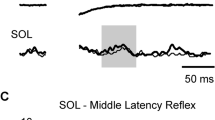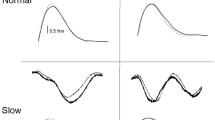Abstract
Light touch at the fingertip has been shown to influence postural control during standing and walking. Interlimb cutaneous reflexes have been proposed to provide a neural link between the upper and lower limbs to assist in interlimb coordination during activities such as walking. In this study, we tested the hypothesis that cutaneous sensory pathways linking the arm and leg will be facilitated if subjects use light touch to assist with postural control during treadmill walking. To test this, interlimb cutaneous reflexes from the median nerve, serving the skin contact region, and radial nerve, serving an irrelevant sensory territory, were tested in the legs of subjects walking on treadmill in an unstable environment. Interlimb cutaneous reflexes were tested while subjects (a) touched or (b) did not touch a stable contact with their fingertip, and while the eyes were either (c) open or (d) closed. Reflexes arising from both nerves were facilitated when vision was removed that was then ameliorated when touch was provided. These changes in reflex amplitude during the eyes closed conditions were mirrored by changes in background muscle activity. We suggest that this facilitation of interlimb reflexes from both nerves arises from a generalized increase in excitability related to the postural anxiety of walking on a treadmill with the eyes closed, which is then restored by the provision of light touch. However, the influence of touch when the eyes were open differed depending upon the nerve stimulated. Radial nerve reflexes in the legs were suppressed when touch was provided, mirroring a suppression in the background muscle activity. In contrast, median nerve reflexes in the leg were larger when touch was provided with the eyes open, despite a suppression of background muscle activity. This nerve-specific effect of touch on the amplitude of the interlimb cutaneous reflexes suggests that touch sensory information from the median nerve was facilitated when that input was functionally relevant.




Similar content being viewed by others
References
Adkin AL, Frank JS, Carpenter MG, Peysar GW (2000) Postural control is scaled to level of postural threat. Gait Posture 12:87–93
Brown LA, Gage WH, Polych MA, Sleik RJ, Winder TR (2002) Central set influences on gait. Age-dependent effects of postural threat. Exp Brain Res 145:286–296
Carpenter MG, Frank JS, Silcher CP, Peysar GW (2001) The influence of postural threat on the control of upright stance. Exp Brain Res 138:210–218
Carpenter MG, Frank JS, Adkin AL, Paton A, Allum JHJ (2004) Influence of postural anxiety on postural reactions to multi-directional surface rotations. J Neurophysiol 92:3255–3265
Delbaere K, Sturnieks DL, Crombez G, Lord SR (2009) Concern about falls elicits changes in gait parameters in conditions of postural threat in older people. J Gerontol A Biol Sci Med Sci 64:237–242
Dickstein R, Laufer Y (2004) Light touch and center of mass stability during treadmill locomotion. Gait Posture 20:41–47
Dickstein R, Shupert CL, Horak FB (2001) Fingertip touch improves postural stability in patients with peripheral neuropathy. Gait Posture 14:238–247
Dickstein R, Peterka RJ, Horak FB (2003) Effects of fingertip touch on postural responses in subjects with diabetic neuropathy. J Neurol Neurosurg Psychiatry 74:620–626
Dietz V (2002) Do human bipeds use quadrupedal coordination? Trends Neurosci 25:462–467
Duysens J, Trippel M, Horstmann GA, Dietz V (1990) Gating and reversal of reflexes in ankle muscles during human walking. Exp Brain Res 82:351–358
Feldman F, Robinovitch SN (2007) Reducing hip fracture risk during sideways falls: evidence in young adults of the protective effects of impact to the hands and stepping. J Biomech 40:2612–2618
Forero J, Misiaszek JE (2013) The contribution of light touch sensory cues to corrective reactions during treadmill locomotion. Exp Brain Res 226:575–584
Forero J, Misiaszek JE (2014a) The effect of light touch on the amplitude of cutaneous reflexes in the arms during treadmill walking. Exp Brain Res 232:2967–2976
Forero J, Misiaszek JE (2014b) Balance-corrective responses to unexpected perturbations at the arms during treadmill walking. J Neurophysiol 112:1790–1800
Hallemans A, Beccu S, Van Loock K, Ortibus E, Truijen S, Aerts P (2009) Visual deprivation leads to gait adaptations that are age- and context-specific: II. Kinematic parameters. Gait Posture 30:307–311
Haridas C, Zehr EP (2003) Coordinated interlimb compensatory responses to electrical stimulation of cutaneous nerves in the hand and foot during walking. J Neurophysiol 90:2850–2861
Haridas C, Zehr EP, Misiaszek JE (2005) Postural uncertainty leads to dynamic control of cutaneous reflexes from the foot during human walking. Brain Res 1062:48–62
Haridas C, Zehr EP, Misiaszek JE (2006) Context-dependent modulation of interlimb cutaneous reflexes in arm muscles as a function of stability threat during walking. J Neurophysiol 96:3096–3103
Holden M, Ventura J, Lackner JR (1994) Stabilization of posture by precision contact of the index finger. J Vestib Res 4:285–301
Jeka JJ (1997) Light touch contact as a balance aid. Phys Ther 77:476–487
Jeka J, Lackner JR (1994) Fingertip contact influences human postural control. Exp Brain Res 100:495–502
Johannsen L, Wing AM, Hatzitaki V (2007) Effects of maintaining touch contact on predictive and reactive balance. J Neurophysiol 97:2686–2695
Kouzaki M, Masani K (2008) Reduced postural sway during quiet standing by light touch is due to finger tactile feedback but not mechanical support. Exp Brain Res 188:153–158
Maki BE, McIlroy WE (2006) Control of rapid limb movements for balance recovery: age-related changes and implications for fall prevention. Age Ageing 35(Suppl 2):ii12–ii18
Marigold DS, Misiaszek JE (2009) Whole-body responses: neural control and implications for rehabilitation and fall prevention. Neuroscientist 15:36–46
Matthews PB (1986) Observations on the automatic compensation of reflex gain on varying the pre-existing level of motor discharge in man. J Physiol 374:73–90
Misiaszek JE (2003) Early activation of arm and leg muscles following pulls to the waist during walking. Exp Brain Res 151:318–329
Misiaszek JE, Krauss EM (2004) Compensatory arm reactions when holding a stable support during walking. Program No. 180.4. 2004 Neuroscience Meeting Planner. San Diego, Ca: society For Neuroscience, 2004. Online
Misiaszek JE, Krauss EM (2005) Restricting arm use enhances compensatory reactions of leg muscles during walking. Exp Brain Res 161:474–485
Misiaszek JE, Stephens MJ, Yang JF, Pearson KG (2000) Early corrective reactions of the leg to perturbations at the torso during walking in humans. Exp Brain Res 131:511–523
Prochazka A (1989) Sensorimotor gain control: a basic strategy of motor systems? Prog Neurobiol 33:281–307
Rietdyk S, Patla AE (1997) Context-dependent reflex control: some insights into the role of balance. Exp Brain Res 119:251–259
Rogers MW, Wardman DL, Lord SR, Fitzpatrick RC (2001) Passive tactile sensory input improves stability during standing. Exp Brain Res 136:514–522
Roos PE, McGuigan MP, Kerwin DG, Trewartha G (2008) The role of arm movement in early trip recovery in younger and older adults. Gait Posture 27:352–356
Sakamoto M, Endoh T, Nakajima T, Tazoe T, Shiozawa S, Komiyama T (2006) Modulations of interlimb and intralimb cutaneous reflexes during simultaneous arm and leg cycling in humans. Clin Neurophysiol 117:1301–1311
Wing AM, Johannsen L, Endo S (2011) Light touch for balance: influence of a time-varying external driving signal. Philos Trans R Soc Lond B Biol Sci 366:3133–3141
Yang JF, Stein RB (1990) Phase-dependent reflex reversal in human leg muscles during walking. J Neurophysiol 63:1109–1117
Zehr EP, Duysens J (2004) Regulation of arm and leg movement during human locomotion. Neuroscientist 10:347–361
Zehr EP, Haridas C (2003) Modulation of cutaneous reflexes in arm muscles during walking: further evidence of similar control mechanisms for rhythmic human arm and leg movements. Exp Brain Res 149:260–266
Zehr EP, Kido A (2001) Neural control of rhythmic, cyclical human arm movement: task dependency, nerve specificity and phase modulation of cutaneous reflexes. J Physiol 537:1033–1045
Zehr EP, Komiyama T, Stein RB (1997) Cutaneous reflexes during human gait: electromyographic and kinematic responses to electrical stimulation. J Neurophysiol 77:3311–3325
Zehr EP, Stein RB, Komiyama T (1998) Function of sural nerve reflexes during human walking. J Physiol 507:305–314
Zehr EP, Collins DF, Chua R (2001) Human interlimb reflexes evoked by electrical stimulation of cutaneous nerves innervating the hand and foot. Exp Brain Res 140:495–504
Acknowledgments
This work was funded by a Natural Sciences and Engineering Research Council (Canada) grant to JEM.
Author information
Authors and Affiliations
Corresponding author
Rights and permissions
About this article
Cite this article
Forero, J., Misiaszek, J.E. The amplitude of interlimb cutaneous reflexes in the leg is influenced by fingertip touch and vision during treadmill locomotion. Exp Brain Res 233, 1773–1782 (2015). https://doi.org/10.1007/s00221-015-4250-8
Received:
Accepted:
Published:
Issue Date:
DOI: https://doi.org/10.1007/s00221-015-4250-8




